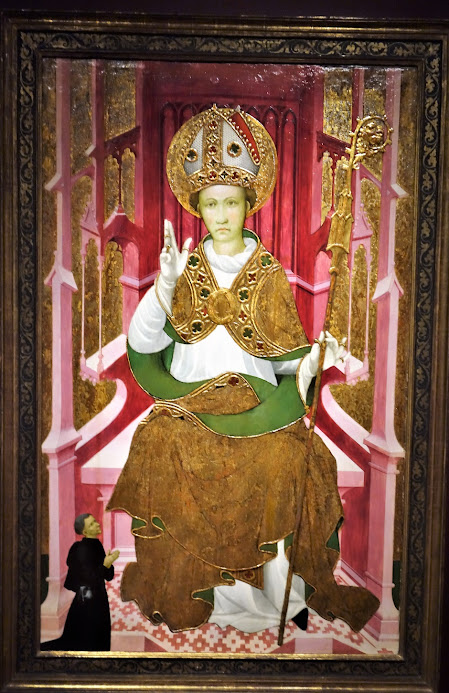Fortunately, I took lots of photos when I last visited Cleveland Museum of Art in November just before the museum was closed again due to the pandemic. I still have enough pictures from the galleries of medieval art to publish a couple more entries.
One gallery contains religious art from medieval Italy. It is interesting to note that as Italy progresses toward the Renaissance, the artists are no longer working anonymously, creating their works simply for the glory of God. Now their names are known to us centuries later.
This altarpiece of the Virgin and Child with Saints dates from around 1320. It probably came from a Franciscan church since the artist, Ugolino de Neri di Siena, made his career painting for Franciscan communities.
This cross is from Venice in the late 13th century. It is made from pieces of rock crystal that have been drilled through the center and connected with gold rods. Venice at that time was an important center for the cutting of rock crystal.
This painting, done on a wood panel with tempera paint and gold, juxtaposes the Madonna and Child with the Temptation of Eve at the bottom. It was painted around 1400 in central Italy by Olivuccio de Ciccarello.
This sculpture of the Madonna and Child flanked by St. Catherine and John the Baptist is carved from alabaster and still has some traces of paint and gilding. It was done by Giovanni de Agostino in 1340.
This Madonna and Child was painted around 1405 by Spinello Aretino. The artist shows the influence of the famous painter Giotto, a precursor of the Renaissance.
Moving to another gallery, we come to this stained glass window from 15th century France. The window portrays St. Catherine and a kneeling cleric.
This window comes from late 14th century England. An angel collects the blood of the crucified Jesus in a chalice. The grapevine reinforces the concept of the Eucharistic wine as the blood of Christ.
This 15th century alabaster panel comes from an altarpiece from Nottingham, England.
Moving on to objects from medieval Spain, we come to this large, decorative bowl of glazed earthenware from 15th century Valencia.
This wooden crucifix dates from the late 1300s and comes from Navarre, Spain. It would have been suspended over an altar.
Dating back to around 1300, this walnut panel comes from a choir stall in the Convent of Pedralbes in Catalonia, Spain.
This painting of a Bishop Saint (perhaps St. Louis of Toulouse) is also from Catalonia at around the same time. Notice the tiny figure dressed in black at the bottom. It is a portrait of the donor who paid for the painting.
This painting of The Birth and Naming of John the Baptist was commissioned by Queen Isabella of Spain in the late 1400s. It was painted by Juan de Flandés, a Flemish painter who was active in Spain. It once hung in the Carthusian monastery of Miraflores outside of Burgos, where Isabella's parents are buried. (I visited that monastery some years ago on one of my trips to Spain.)
Finally, this Book of Hours, a book of devotional readings, belonged to Queen Isabella. It's amazing to think that this was held in the hands of that famous monarch. Beautifully illuminated, it was created by Flemish manuscript painters around 1500 as the Renaissance is about to dawn upon Europe.
Still to come... German and Austrian medieval art and French tapestries from the early 1500s.















Test
ReplyDeleteWell, it works. I’ve been trying to leave a comment on your Christmas Card post to let you know it arrived. It doesn’t seem to work. Weird, but never mind! Garcia’s amigo and merry Christmas.
DeleteStrange that you could reply on this post but not on the other. Anyway, I'm glad that you received the card, and may you both have a merry Christmas!
Delete